In this blog post, we will organize and explain the radio frequencies (bands) assigned to Japanese mobile phone operators (MNO: Mobile Network Operator). The radio frequencies used in 5G/4G/3G mobile phone communication services use a variety of different frequency bands. In addition, the bands used by mobile phone communication services for each frequency (from exact which frequency to which frequency) are precisely determined.
Japanese mobile phone operators (MNO: Mobile Network Operator) are the following companies. In this article, we will organize and explain the exact frequencies held by each Japanese mobile phone operator below. By comparing them, you can understand the characteristics of each operator.
- NTT Docomo
- KDDI and UQ communications
- Softbank and WCP (Wireless City Planning)
- Rakuten
- Docomo, KDDI, Softbank, Rakuten 5G/4G band list
- NTT Docomo band details
- Bands owned by NTT Docomo and their bandwidth
- NTT Docomo’s allocated band list and accurate radio frequency bands
- NTT Docomo 5G frequency (millimeter wave, Sub6): 28GHz band (n257), 4.5GHz band (n79), 3.7GHz band (n77/n78)
- NTT Docomo (4G Sub6): 3.5GHz band (band 42), 2.5GHz band (band 41)
- NTT Docomo (low band): 2.0GHz band (band 1), 1.7GHz band (band 3/band 9), 1.5GHz band (band 21)
- NTT Docomo (Platinum Band): 800Hz band (band 26/band 19), 700MHz band (band 28)
- KDDI and UQ Communications band details
- Bands owned by KDDI and UQ Communications and their bandwidth
- Frequencies assigned to KDDI and UQ Communications (band list)
- KDDI 5G frequency (millimeter wave, Sub6): 28GHz band (n257), 3.7GHz band (n77/n78)
- KDDI (4G Sub6): 3.5GHz band (band 42), 2.5GHz band (band 41), 2.3GHz (band 40)
- KDDI (low band): 2.0GHz band (band 1), 1.7GHz band (band 3/band 9), 1.5GHz band (band 11)
- KDDI (Platinum Band): 800Hz band (band 26/band 18), 700MHz band (band 28)
- Softbank band details
- Bands owned by Softbank and their bandwidth
- List of Softbank allocated bands and accurate radio frequency bands
- Softbank’s 5G frequency (millimeter wave, Sub6): 28GHz band (n257), 3.7GHz band (n77)
- Softbank’s 4G Sub6: 3.5GHz band (band 42), 2.5GHz band (band 41)
- Softbank low band: 2.0GHz band (band 1), 1.7GHz band (band 3/band 9), 1.5GHz band (band 11)
- Softbank Platinum Band: 900Hz band (band 8), 700MHz band (band 28) / Softbank Platinum Band: 900Hz band (band 8), 700MHz band (band 28)
- Rakuten band details
- summary
Docomo, KDDI, Softbank, Rakuten 5G/4G band list
Bands for mobile phones in Japan (explained in general)
In Japan, various frequency bands are used for mobile phone communications, from the low frequency 700MHz band to the high frequency 28GHz (28,000MHz) band (see the table below). For most frequency bands, 5G/4G/3G communication methods and worldwide common frequency bands have been determined.
In order to allow 5G/4G/3G wireless network equipment and smartphones to be used globally, the communication methods (5G/4G/3G and TDD/FDD) and frequency bands to be used have been determined globally. This is because by deciding on a universal communication method and frequency band to be used, various benefits such as international roaming become possible.
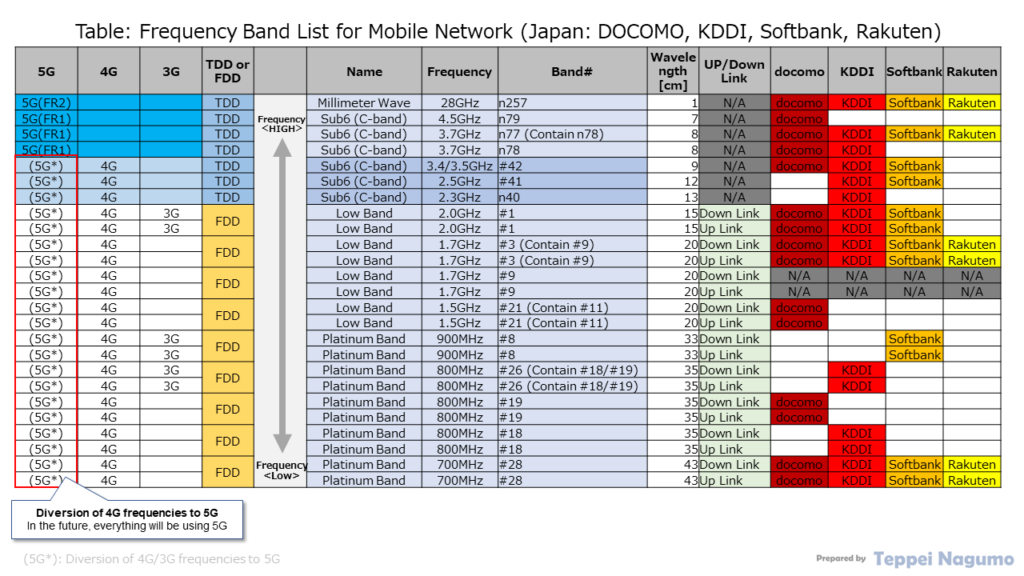
This table is explained in detail below.
5G and 4G band names and radio frequency
Each frequency band used for mobile phone communication is defined by standardization organizations around the world as to exactly which frequency the radio waves range.
Each frequency band used for mobile phone communication for 5G NR (New Radio) is defined by a number. For example, n77 is the Sub-6 5G frequency band in the 3.7GHz band. A detailed list of bands allocated for 5G NR is summarized in the link below.
5G new radio frequency band, Wikipedia, [Link]
Each frequency band used for 4G LTE mobile phone communications is defined by a number. For example, band-1 is a low-band frequency in the 2.0GHz. A detailed list of bands allocated for 4G LTE is summarized in the link below.
4G LTE band list, Wikipedia, [Link]
Radio frequency bandwidth assigned to each Japanese carrier (NTT Docomo, KDDI, Softbank, Rakuten)
The table and graph below organize the band names and frequency bandwidths assigned to each Japanease mobile operator.
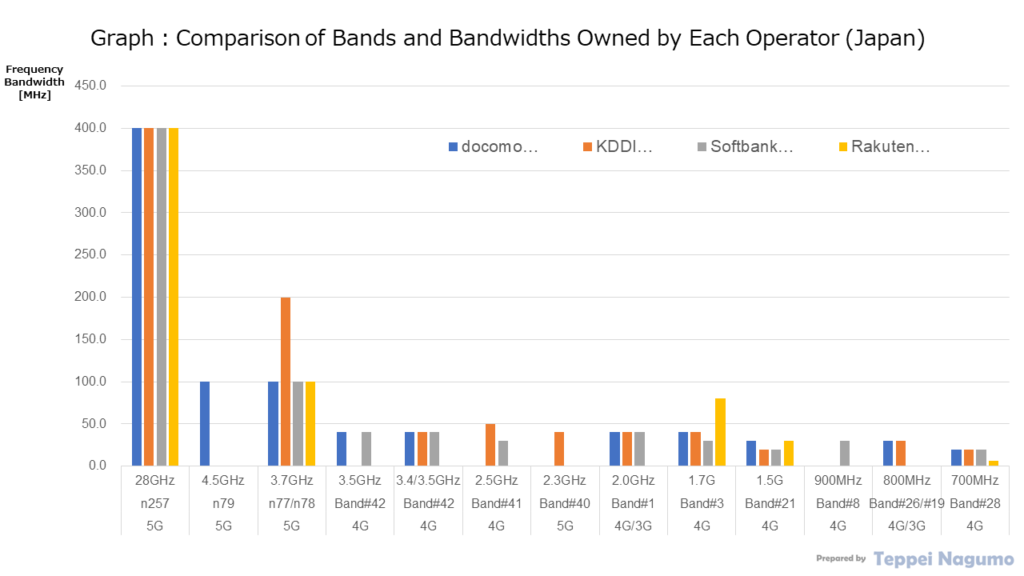
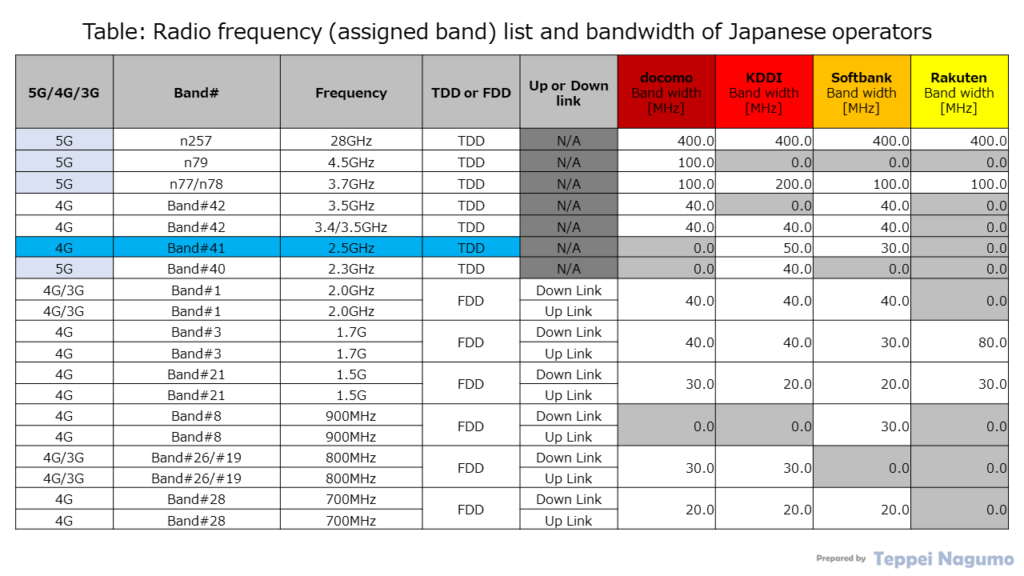
For more information on the differences in wireless frequencies (bands) and their relationship to wireless communication area and communication speed, please refer to the article below.
NTT Docomo band details
Bands owned by NTT Docomo and their bandwidth
The graph shows the frequency bands owned by NTT Docomo and the bandwidth of each band (see the figure below). NTT Docomo owns a large number of frequencies, from 5G millimeter waves (high frequencies) to platinum bands (low frequencies), and operates mobile communication services using these frequencies.
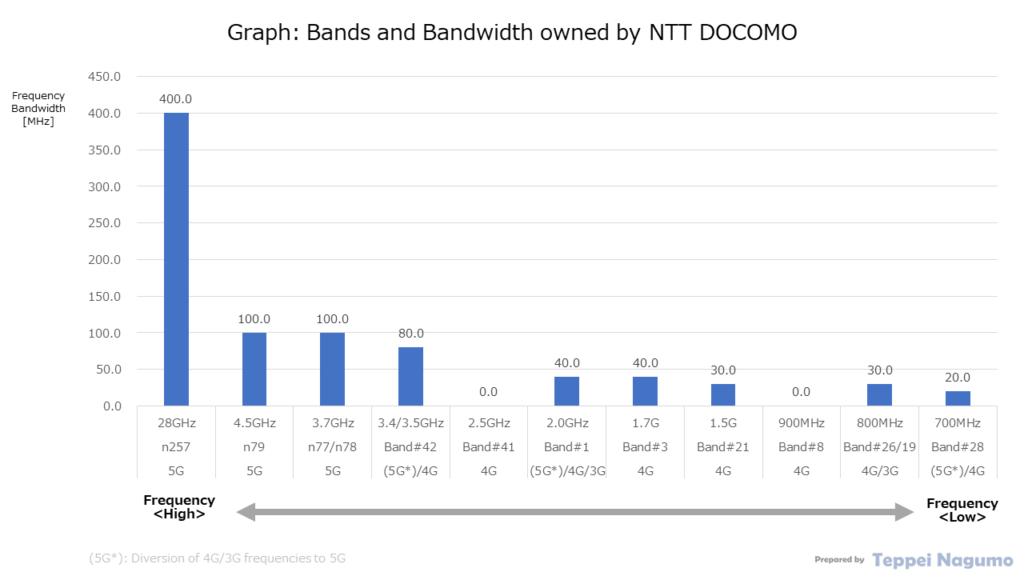
NTT Docomo’s allocated band list and accurate radio frequency bands
We have organized the frequency bands owned by NTT Docomo and the exact values of the bandwidth of each band in a table (see the table below). For each frequency band, we are organizing the exact frequencies that are allocated to NTT Docomo.
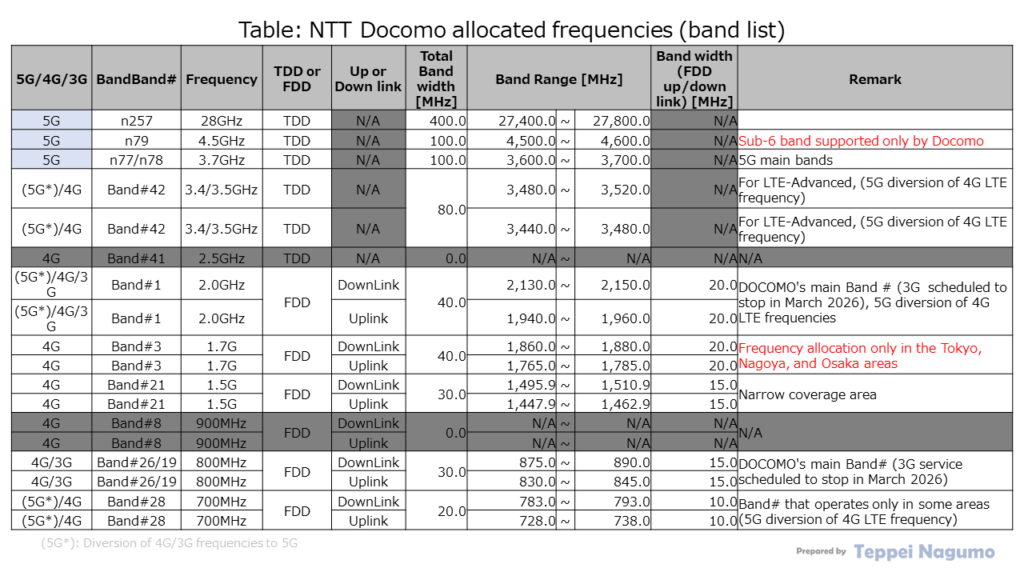
NTT Docomo 5G frequency (millimeter wave, Sub6): 28GHz band (n257), 4.5GHz band (n79), 3.7GHz band (n77/n78)
The 28GHz band (n257) is a band that will take time to become popular. The area is very limited because the radio waves do not travel well and do not penetrate inside buildings. As a hotspot, it is expected that it will be deployed over time at large train stations and downtown areas in large cities with high traffic.
The 4.5GHz band (n79) is a band supported only by NTT Docomo, and is a band that is not expected to be used for 5G NR worldwide.
The 3.7GHz band (n77/n78) is NTT Docomo’s main 5G band. The number of 5G base stations in this frequency band is expected to increase.
NTT Docomo (4G Sub6): 3.5GHz band (band 42), 2.5GHz band (band 41)
The 3.5GHz band (band 42) is the band for LTE-Advanced. Frequencies in other bands are used simultaneously using CC (carrier aggregation) technology. This is a frequency band developed to cover high-volume traffic. Also, in this 3.5GHz band, 4G frequencies are being diverted to 5G.
The 2.5GHz band (band 41) has very few base stations and is hardly in operation.
NTT Docomo (low band): 2.0GHz band (band 1), 1.7GHz band (band 3/band 9), 1.5GHz band (band 21)
The 2.0GHz band (band 1) is NTT Docomo’s main band. 3G is also widely deployed across the country. 3G service is scheduled to stop in March 2026. Additionally, in this 700MHz band, 4G/3G frequencies are being repurposed as 5G frequencies.
The 1.7GHz band (band 3/band 9) is a frequency assigned only to the metropolitan areas of Tokyo, Nagoya, and Osaka.
The 1.5GHz band (band 21) is a frequency band with a limited area.
NTT Docomo (Platinum Band): 800Hz band (band 26/band 19), 700MHz band (band 28)
The 800Hz band (Band 26/Band 19) is NTT DoCoMo’s main band and is widely used nationwide for 4G LTE and 3G. This is a low frequency band called the platinum band, which allows radio waves to spread widely and secure a wide wireless area for mobile phones. However, the communication speed is lower compared to higher frequencies.
The 700MHz band (band 28) is a band that is operated by 4G LTE only in some areas. In addition, this 700MHz band is being diverted to the 5G frequency of 4G/3G frequencies.
KDDI and UQ Communications band details
Bands owned by KDDI and UQ Communications and their bandwidth
The graph shows the frequency bands owned by KDDI and the bandwidth of each band (see the figure below). KDDI owns a large number of frequencies, from 5G millimeter waves (high frequencies) to platinum bands (low frequencies), and operates mobile communication services using these frequencies.
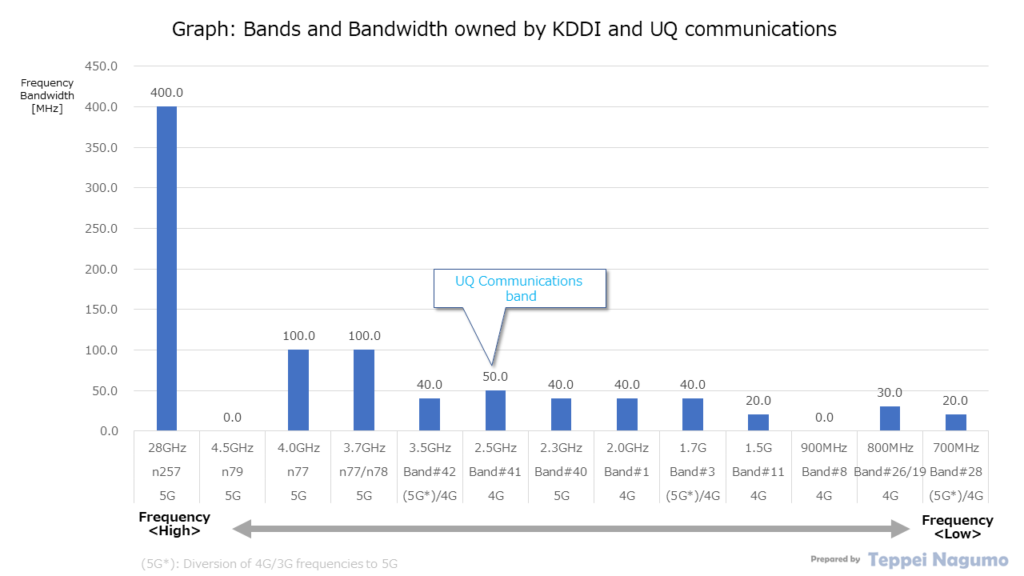
Frequencies assigned to KDDI and UQ Communications (band list)
We have organized the frequency bands owned by KDDI group and the exact values of the bandwidth of each band in a table (see the table below).
The frequency allocation to UQ Communications is a total of 50MHz of 2.5GHz (band 41).
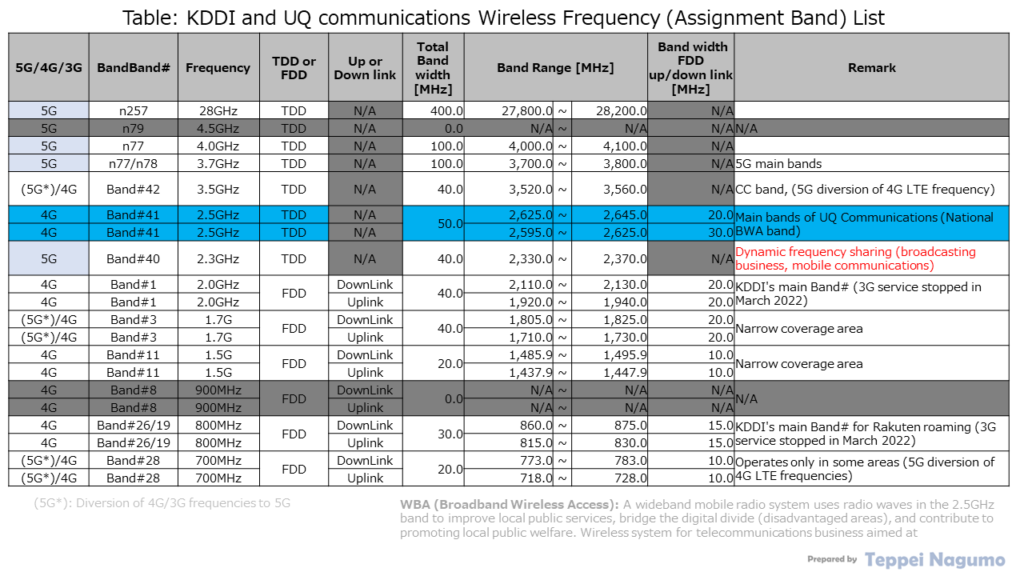
KDDI 5G frequency (millimeter wave, Sub6): 28GHz band (n257), 3.7GHz band (n77/n78)
The 28GHz band (n257) is a band that will take time to become popular. The area is very limited because the radio waves do not travel well and do not penetrate inside buildings. As a hotspot, it is expected that it will be deployed over time at large stations and downtown areas in large cities with high traffic.
The 3.7GHz band (n77/n78) is KDDI’s main 5G band. The number of 5G base stations in this frequency band is expected to increase.
KDDI (4G Sub6): 3.5GHz band (band 42), 2.5GHz band (band 41), 2.3GHz (band 40)
The 3.5GHz band (band 42) is the band for LTE-Advanced. Frequencies in other bands are used simultaneously using CC (carrier aggregation) technology. This is a frequency band developed to cover high-volume traffic. Also, in this 3.5GHz band, 4G frequencies are being diverted to 5G.
The 2.5GHz band (band 41) is the band assigned to UQ Communications. It has a total bandwidth of 50MHz and is deployed and operated nationwide. This band is also the national BWA (Broadband Wireless Access) band.
In the 2.3GHz band (band 40), a 40MHz wide band was allocated to KDDI in April 2022. This band will be operated by Dynamic Frequency Sharing between the Broadcasting Business and KDDI’s Mobile Communications Business (5G). By the end of March 2027, KDDI plans to launch service with more than 8,300 base stations in this band.
This band is originally used by FPUs (broadcasting business radio stations) that wirelessly transmit video from the reporting site for broadcast programs such as sports broadcasts.
KDDI (low band): 2.0GHz band (band 1), 1.7GHz band (band 3/band 9), 1.5GHz band (band 11)
The 2.0GHz band (band 1) is KDDI’s main band. 3G service stopped in March 2022.
The 1.7GHz band (band 3/band 9) is a frequency band with a limited area.
The 1.5GHz band (band 11) is a frequency band with a limited area.
KDDI (Platinum Band): 800Hz band (band 26/band 18), 700MHz band (band 28)
The 800Hz band (Band 26/Band 18) is KDDI’s main band and is widely deployed nationwide with 4G LTE. 3G service stopped in March 2022. This band is lent to Rakuten for roaming. As a result, Rakuten traffic is flowing in rural areas.
The 700MHz band (band 28) is a band that is operated by 4G LTE only in some areas. In addition, this 700MHz band is being diverted to 5G, which is a 4G frequency.
*KDDI seems to be conducting 5G NR and 4G LTE DSS (Dynamic Spectrum Sharing) using the 4G band frequency. The specific band in which DSS is operated has not been disclosed.
Softbank band details
Bands owned by Softbank and their bandwidth
The graph shows the frequency bands owned by SoftBank and the bandwidth of each band (see the figure below). SoftBank owns a large number of frequencies, from 5G millimeter waves (high frequencies) to platinum bands (low frequencies), and operates mobile communication services using these frequencies.
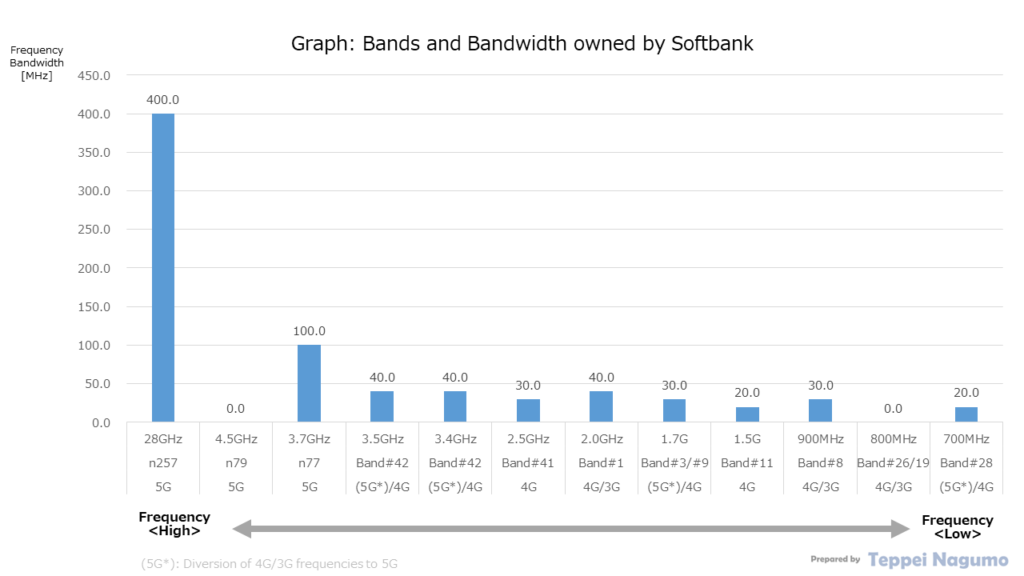
List of Softbank allocated bands and accurate radio frequency bands
We have organized the frequency bands owned by SoftBank and the exact values of the bandwidth of each band in a table (see the table below). For each frequency band, we are organizing the exact frequencies that are allocated to SoftBank.
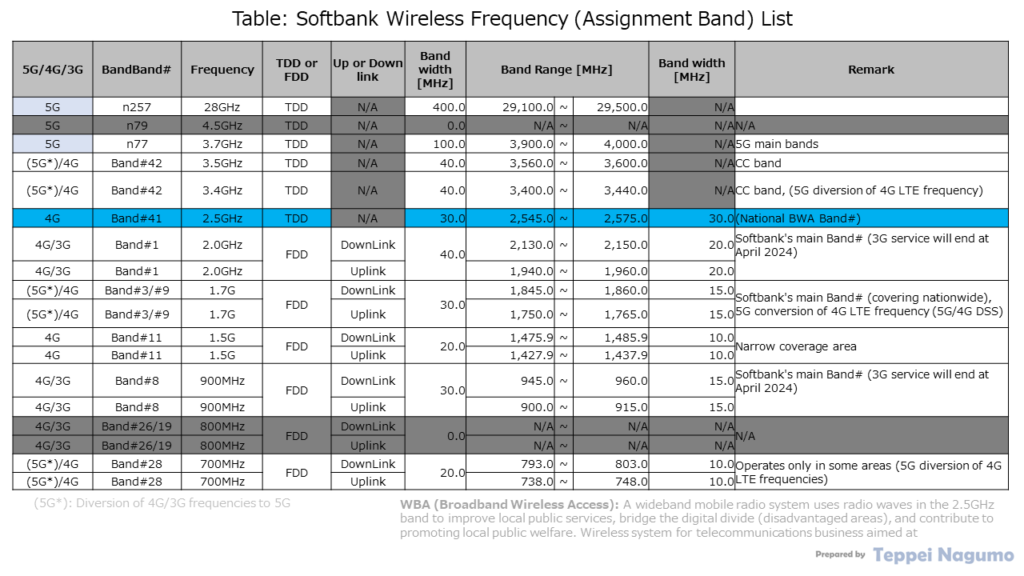
Softbank’s 5G frequency (millimeter wave, Sub6): 28GHz band (n257), 3.7GHz band (n77)
The 28GHz band (n257) is a band that will take time to become popular. The area is very limited because the radio waves do not travel well and do not penetrate inside buildings. As a hotspot, it is expected that it will be deployed over time at large stations and downtown areas in large cities with high traffic.
The 3.7GHz band (n77) is SoftBank’s main 5G band. The number of 5G base stations in this frequency band is expected to increase.
Softbank’s 4G Sub6: 3.5GHz band (band 42), 2.5GHz band (band 41)
The 3.5GHz band (band 42) is the band for LTE-Advanced. Frequencies in other bands are used simultaneously using CC (carrier aggregation) technology. This is a frequency band developed to cover high-volume traffic. Also, SoftBank is using this band to convert 4G frequencies to 5G.
The 2.5GHz band (band 41) is SoftBank’s main band. It is deployed and operated nationwide. This band was used by WCP (Wireless City Planning), which is now Softbank. This band is also the national BWA (Broadband Wireless Access) band.
Softbank low band: 2.0GHz band (band 1), 1.7GHz band (band 3/band 9), 1.5GHz band (band 11)
The 2.0GHz band (band 1) is SoftBank’s main band. It is deployed and operated nationwide. 3G service will stop in January 2024.
The 1.7GHz band (band 3/band 9) is SoftBank’s main band. It is deployed and operated nationwide. In some areas, 4G frequencies are being diverted to 5G.
The 1.5GHz band (band 11) is a frequency band with a limited area.
Softbank Platinum Band: 900Hz band (band 8), 700MHz band (band 28) / Softbank Platinum Band: 900Hz band (band 8), 700MHz band (band 28)
The 900Hz band (band 8) is SoftBank’s main band. It is deployed and operated nationwide. 3G service will stop in January 2024.
The 700MHz band (band 28) is a band that is operated only in some areas. In some areas, 4G frequencies are being converted to 5G. Also, in this 700MHz band, 4G frequencies are being diverted to 5G.
Rakuten band details
Rakuten owned bands and their bandwidth
The graph shows the frequency bands owned by Rakuten and the bandwidth of each band (see the figure below). Rakuten is a mobile network operator (MNO: Mobile Network Operator) that launched a new service in 2019. Therefore, there are fewer frequencies available.
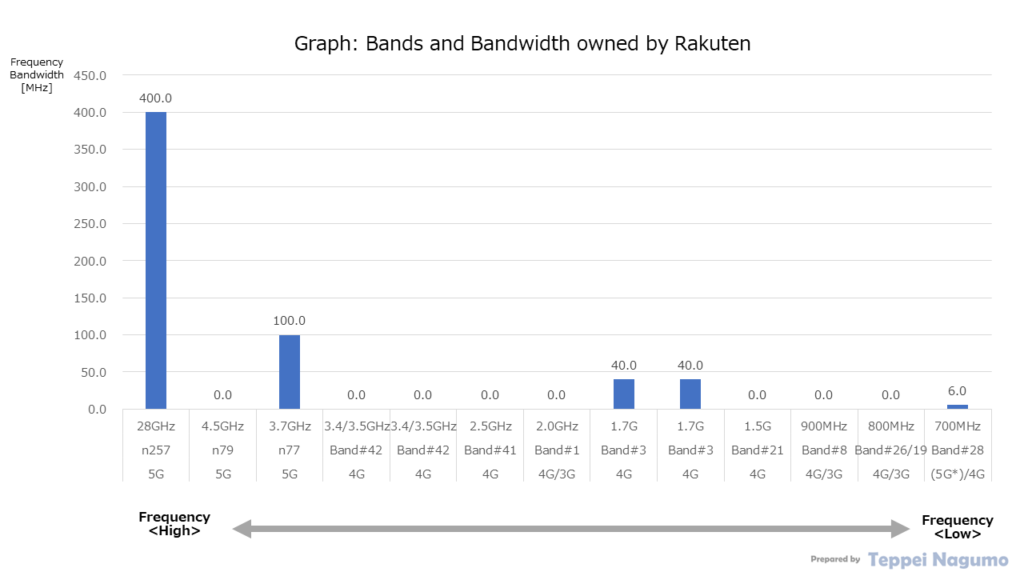
Rakuten’s assigned band list and accurate radio frequency bands
We have organized the frequency bands owned by Rakuten and the exact values of the bandwidth of each band in a table (see the table below). For each frequency band, we organize the exact frequencies that are allocated to Rakuten.
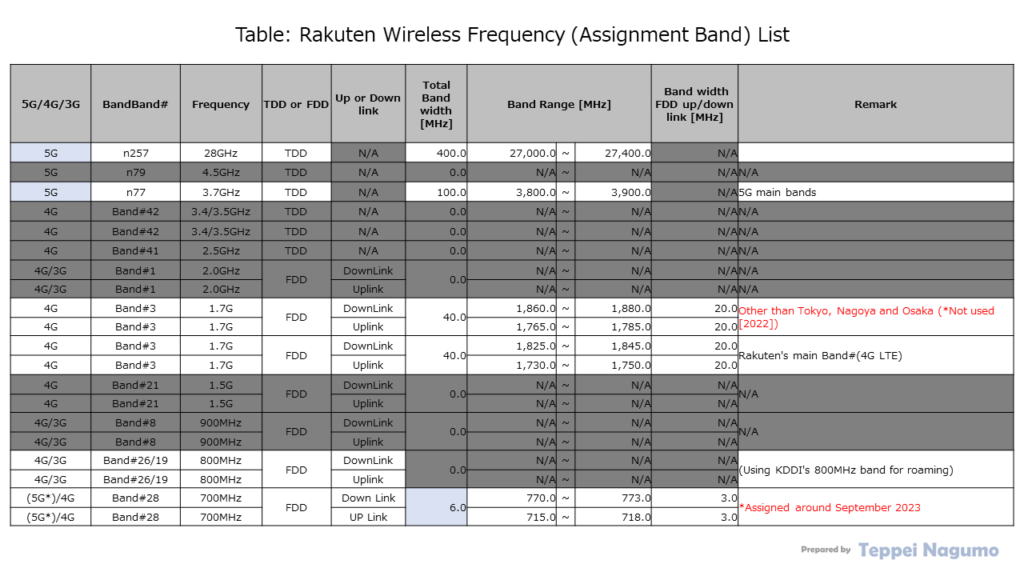
The 28GHz band (n257) is a band that will take time to become popular. The area is very limited because the radio waves do not travel well and do not penetrate inside buildings. As a hotspot, it is expected that it will be deployed over time at large stations and downtown areas in large cities with high traffic.
The 3.7GHz band (n77) is Rakuten’s main 5G band.
Rakuten low band: 1.7GHz band (band 3/band 9)
Band 3/Band 9 (1.7GHz band) is Rakuten’s main band. It is being deployed and operated nationwide with 4G LTE. Most of Rakuten’s base stations are for this band.
Rakuten Platinum Band: 800Hz band (band 26/band 19) – *KDDI roaming
The 800Hz band (band 26/band 19) is not assigned to Rakuten. Rakuten uses KDDI’s band for roaming in rural areas that cannot be covered by its own base stations.
Rakuten Platinum Band: 700Hz band (band 28)
Frequencies were allocated in the 700Hz band (band 28) with a bandwidth of 3MHz uplink (715Mhz to 718MHz) and 3MHz downlink (770Mhz to 773MHz). (September 2023).
If this frequency is assigned, it may contribute to expanding Rakuten’s service area. The total bandwidth is 6MHz (=3MHz uplink width + 3MHz downlink width) and the bandwidth is narrow. It can mainly be used to expand the service area, but it cannot be expected to handle high communication speeds or large amounts of traffic.
summary
In this blog post, we have organized and explained the radio frequencies (bands) assigned to Japanese mobile phone operators (MNO: Mobile Network Operator). We also explained the frequencies of each mobile phone carrier: Docomo, KDDI, Softbank, and Rakuten.
Please check the blog post below for details on the number of base stations for each operator in Japan.
Please refer to the blog post below for Details of radio frequency allocation for mobile communications (diagram showing bandwidth and adjacency relationships) for each Japanese mobile carrier.
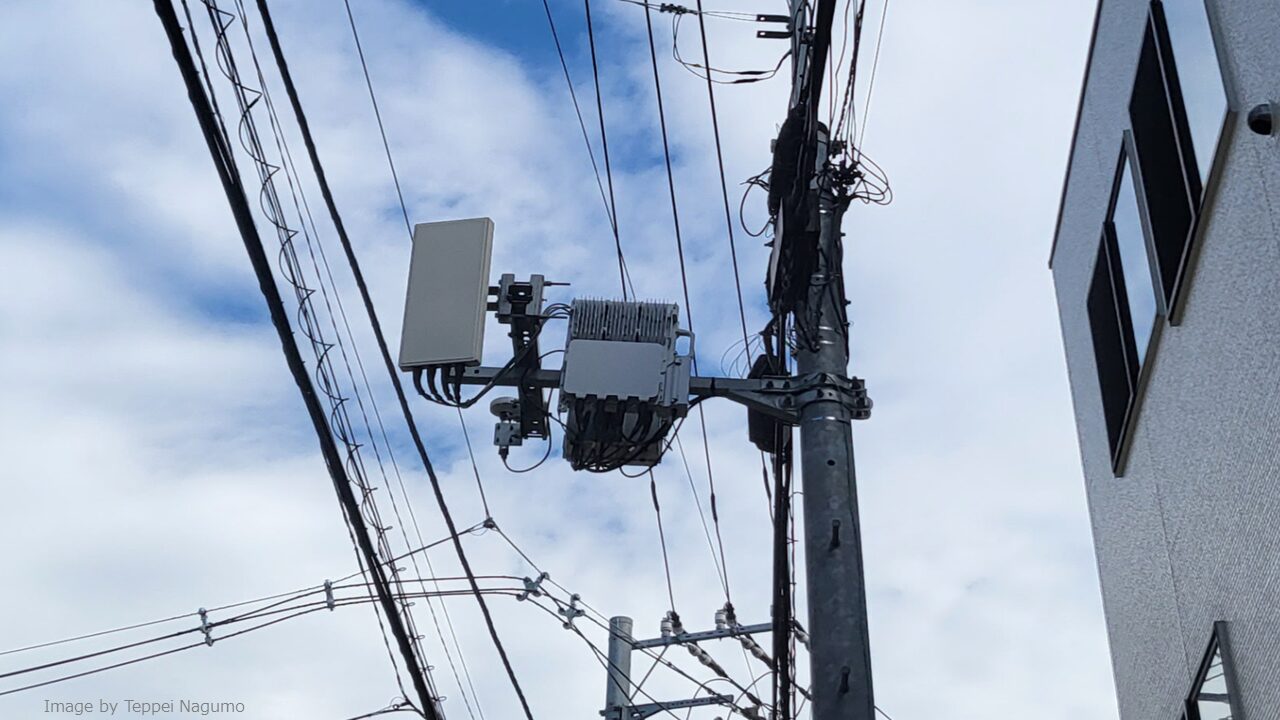





コメント